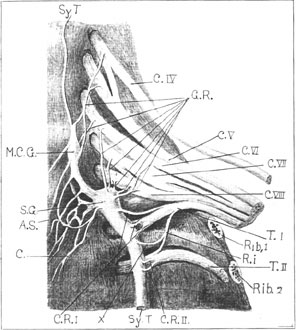Articles - Research topics relating to ETS

Fig.
1. - Drawing from the cadaver to illustrate the inconstant intrathoracic
ramus from the second to the first thoracic nerve and the communicating
rami joining the brachial plexus. In the illustrations, A. S.
indicates the ansa subclavia; C., the cardiac nerves; C. IV to
C. VIII, cervical nerves; C. R. I, communicating rami to first
thoracic nerve; C. R. II, communicating rami to second thoracic
nerve; G. R., gray communicating rami to cervical nerves; M.
C. G., middle cervical ganglion; R. i, inconstant intrathoracic
ramus from second to first thoracic nerve; 5. G., stellate ganglion;
Sy. T., sympathetic trunk; X, sympathetic ramus joining the ramus
from the second to the first thoracic nerve; T. I, first thoracic
nerve; T. 11, second thoracic nerve. |
The second thoracic nerve is commonly connected with the second thoracic sympathetic ganglion or the sympathetic trunk by a white and a gray ramus. In some of the cases in the present study, a gray ramus from the second thoracic sympathetic ganglion or the sympathetic trunk was traced directly into the ramus connecting the first and second thoracic nerves (fig. 1 x). In other cases a ramus from the stellate ganglion was also traced into this ramus. In all cases in which a gray ramus was traced from the second thoracic ganglion or the sympathetic trunk directly into the ramus joining the first thoracic nerve, one or more communicating rami also joined the second thoracic nerve. Not infrequently, a communicating ramus joined the second thoracic nerve at or near the point of origin of the ramus that joins the first thoracic nerve. Sometimes it was apparent that some of the fibers in the communicating ramus joined the ramus leading to the first thoracic nerve. In a few instances a small ramus was traced into the first thoracic nerve directly from the second thoracic sympathetic ganglion or the communicating ramus connecting this ganglion with the second thoracic nerve.
| BACK | TOP | NEXT |
|
 |
|
